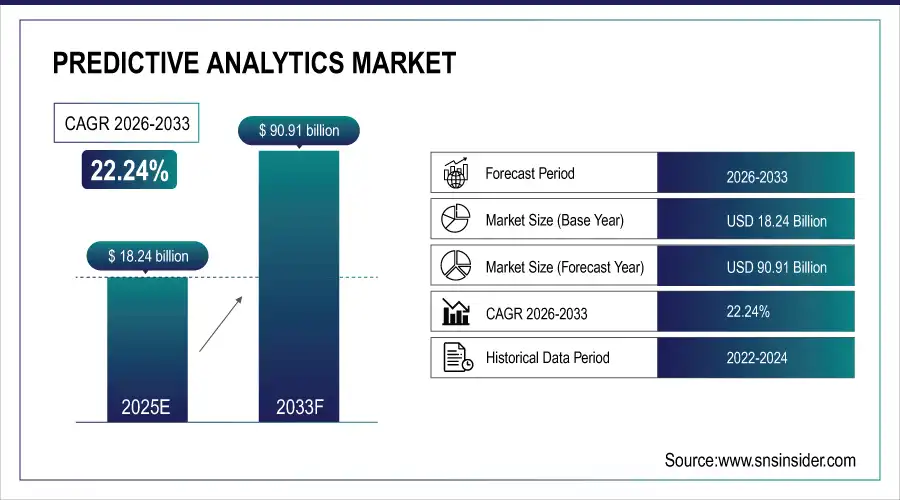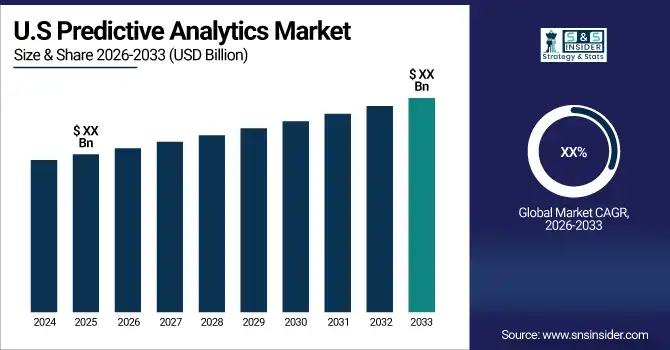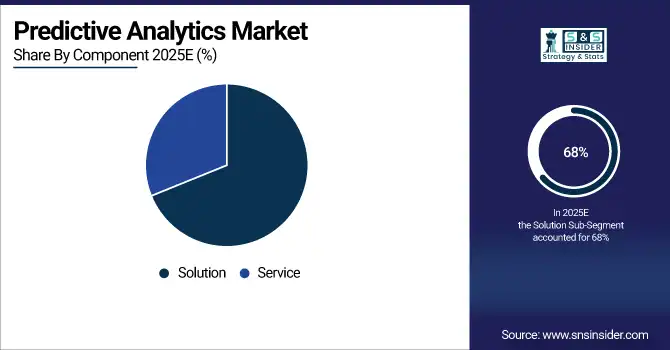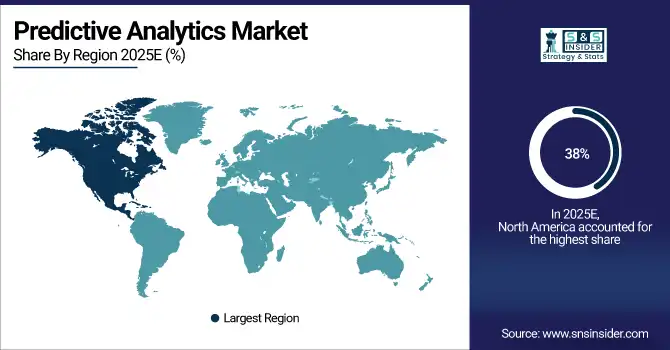Predictive Analytics Market Growth Analysis:
Predictive Analytics Market was valued at USD 18.24 billion in 2025E and is expected to reach USD 90.91 billion by 2033, growing at a CAGR of 22.24% from 2026-2033.
The Predictive Analytics Market is growing due to increasing demand for data-driven decision-making across industries. Adoption of AI, machine learning, and advanced analytics enables organizations to forecast trends, optimize operations, and reduce risks. Rising use of big data, cloud-based platforms, and real-time analytics enhances efficiency and accuracy. Additionally, growing applications in finance, healthcare, retail, and manufacturing, along with the need for personalized customer experiences, drive market expansion globally.
Predictive Analytics Market Size and Forecast
-
Market Size in 2025E: USD 18.24 Billion
-
Market Size by 2033: USD 90.91 Billion
-
CAGR: 22.24% from 2026 to 2033
-
Base Year: 2025E
-
Forecast Period: 2026–2033
-
Historical Data: 2022–2024

Get more information on Predictive Analytics Market - Request Sample Report
Predictive Analytics Market Trends
-
Rising demand for data-driven insights and proactive decision-making is driving the predictive analytics market.
-
Growing adoption of AI, machine learning, and advanced statistical models is enhancing forecasting accuracy.
-
Expansion across BFSI, healthcare, retail, manufacturing, and telecom sectors is fueling market growth.
-
Integration with CRM, ERP, and business intelligence platforms is improving operational efficiency and strategic planning.
-
Increasing need for risk management, customer retention, and sales optimization is shaping adoption trends.
-
Advancements in cloud-based analytics and real-time data processing are boosting accessibility and scalability.
-
Collaborations between software vendors, analytics consultancies, and enterprises are accelerating innovation and global market penetration.

Predictive Analytics Market Growth Drivers:
-
Rising adoption of AI and machine learning technologies driving predictive analytics market growth across multiple industries globally
The integration of AI and machine learning in predictive analytics allows organizations to analyze large datasets, forecast trends, and make informed decisions. Businesses can optimize operations, reduce risks, and enhance customer experience using predictive models. Industries like finance, healthcare, retail, and manufacturing leverage these insights for better planning and strategy. Cloud-based analytics, real-time processing, and scalable platforms further support adoption. Organizations increasingly rely on predictive analytics for competitive advantage, cost reduction, and operational efficiency, fueling widespread deployment and driving overall market growth across regions worldwide.
Predictive Analytics Market Restraints:
-
Data privacy concerns and regulatory compliance challenges restricting predictive analytics adoption
The growing use of personal and sensitive data in predictive analytics raises privacy and security concerns. Organizations must comply with data protection regulations such as GDPR, CCPA, and HIPAA, which can vary across regions and industries. Non-compliance may lead to legal penalties, reputational damage, and customer distrust. Managing and anonymizing large datasets while maintaining model accuracy is complex. These regulatory challenges increase implementation costs and require dedicated resources. Concerns about data misuse or breaches make companies cautious, limiting adoption of predictive analytics solutions, particularly in highly regulated industries like finance, healthcare, and government.
Predictive Analytics Market Opportunities:
-
Integration of cloud computing and advanced analytics offering scalable predictive analytics solutions globally
Cloud-based predictive analytics provides organizations with scalable, cost-effective, and flexible platforms for real-time data processing. Businesses can access advanced tools without significant upfront infrastructure investment. Integration with AI, machine learning, and IoT data sources enhances forecasting accuracy and operational efficiency. Cloud adoption facilitates collaboration across departments and geographies, enabling faster decision-making. SMEs can leverage predictive analytics without heavy capital expenditure, expanding market reach. Additionally, cloud solutions support continuous model updates and analytics automation, creating new revenue streams for vendors and driving growth opportunities in the predictive analytics market worldwide.
Predictive Analytics Market Segmention Analysis:
By Component, solutions segment dominated the Predictive Analytics Market
The largest revenue share (about 68%) was held by the solutions segment in 2025. This dominance of the market is driven by the surging interest in software solutions that provide organizations with comprehensive data analysis results. Both governments and businesses employed solutions across numerous industries, such as healthcare, manufacturing, and retail industry. For example, the U.K. Government’s Office for National Statistics states that businesses working with predictive analytics solutions in 2023 improved their efficiency of decision-making by 25%. In the U.S. healthcare sector, the adoption of predictive analytics software has increased by 21%, with the Department of Health and Human Services proposing the use of predictive technologies in managing a patient’s care.

By Application, Predictive maintenance segment dominated the Predictive Analytics Market
In 2025, the highest share in the global predictive analytics market was held by the predictive maintenance segment in terms of application. One of the primary reasons for this is that machinery and equipment usage in the manufacturing, energy, and transportation industries has been growing at a rapid pace. According to the U.S. Department of Energy, this application of predictive analytics relies on both real-time and historical data to predict when equipment is going to fail and remain unserviceable. This, in turn, allows manufacturers to prevent costly machine downtime. Moreover, this also noted that relatively early preventative maintenance can reduce machinery downtime by up to 35% and maintenance costs by 10-15%, increasing the lifespan of the machine by 20 percent.
By End User, BFSI segment dominated the Predictive Analytics Market
The BFSI (Banking, Financial Services, and Insurance) sector held the highest market share in the predictive analytics market in 2025. This is because the BFSI sector continuously relies on risk management, fraud detection, and the analysis of customer behavior areas where predictive analytics is used extensively. The use of predictive analytics among financial services enables them to forecast market movements and enhance investment strategies and customer experience. In the report by the Federal Reserve in 2023, banks in the United States that used predictive analytics solutions saw a 30% improvement in fraud detection rates. Besides, the European Central Bank observed a 15% decline in loan defaults by financial firms that relied on predictive institutions to determine credit risks in 2023.
Predictive Analytics Market Regional Analysis
North America Predictive Analytics Market Insights
The largest share of the predictive analytics market was held by North America which is around 38% in 2025. One of the reasons for this is the highly developed technological infrastructure of the region, as well as the fact that the U.S. was one of the first countries in which large-scale data and artificial intelligence-driven technologies were adopted. Moreover, many states in the U.S. spent the most money on implementing predictive analytics in such spheres as healthcare, retail, and manufacturing. For example, governmental initiatives like the National AI Initiative Act became the main drivers for predictive analytics market growth.

Do you need any custom research on Predictive Analytics Market - Enquiry Now
Asia Pacific Predictive Analytics Market Insights
Asia-Pacific is the fastest-growing market with a significant compound annual growth rate from 2026 to 2033. The most prominent change is occurring in countries like India and China, which are leading this growth. The growth of the predictive analytics market in these countries is driven by the constant efforts of the government to digitize the country’s economy and further develop its artificial intelligence capabilities. For example, the Indian government announced the Digital India program in 2023, which will invest $1 billion over five years into AI and predictive analytics for market growth.
Europe Predictive Analytics Market Insights
Europe’s Predictive Analytics Market is growing steadily due to increasing adoption of AI, machine learning, and big data across industries. Financial services, healthcare, retail, and manufacturing sectors leverage predictive analytics for improved decision-making, risk management, and operational efficiency. Cloud-based solutions, supportive regulations, and digital transformation initiatives boost platform adoption. Additionally, rising demand for personalized customer experiences, real-time insights, and advanced forecasting contributes significantly to market expansion in Europe.
Middle East & Africa and Latin America Predictive Analytics Market Insights
The Middle East & Africa and Latin America Predictive Analytics Markets are expanding due to growing adoption of data-driven decision-making and AI-based analytics across industries. Rising digital transformation initiatives, cloud computing, and IoT deployment enhance predictive capabilities. Businesses increasingly use analytics for risk management, operational efficiency, and customer insights. Supportive government policies, increasing investment in technology, and growing awareness of predictive solutions further drive market growth in these regions.
Predictive Analytics Market Competitive Landscape:
IBM Corporation
IBM is a global technology leader providing AI, cloud, and enterprise software solutions. Its Watson platform combines machine learning, natural language processing, and predictive analytics to enable intelligent decision-making across industries. IBM emphasizes secure, scalable, and high-performance analytics tools to support government, healthcare, and enterprise operations, enhancing operational efficiency, risk management, and insights-driven strategy implementation.
-
June 2023: Partnered with the U.S. government to integrate Watson-powered predictive analytics into public domains, including healthcare and defense, improving decision-making efficiency and agency security.
Wipro Limited
Wipro is a leading global IT services company specializing in cloud, AI, analytics, and engineering solutions. Its Enterprise AI-Ready Platform enables clients to build customized AI environments for predictive analytics, resource management, and operational efficiency. Wipro focuses on delivering scalable, secure, and automated AI-powered solutions that help enterprises accelerate digital transformation, optimize processes, and gain actionable insights across multiple industries.
-
February 2024: Launched the Enterprise AI-Ready Platform, empowering clients to create personalized AI-grade environments integrated with predictive analytics for operational and resource-management objectives.
Informatica
Informatica is a data-management leader offering cloud-native solutions for integration, governance, and analytics. Its Master Data Management (MDM) solutions ensure high-quality, trusted data for enterprise applications. Informatica enables businesses to streamline AI, machine-learning, and predictive-analytics initiatives by providing clean, reliable, and integrated datasets, enhancing insights, operational efficiency, and decision-making across retail, financial, and healthcare sectors.
-
April 2024: Partnered with Google Cloud to launch the Master Data Management Extension for BigQuery, facilitating access to trustworthy MDM data for analytics and generative AI applications.
Microsoft Corporation
Microsoft provides enterprise-grade cloud, AI, and data solutions via Azure, Power BI, and Dynamics 365. Its predictive analytics capabilities support resource planning, urban management, and operational optimization, integrating AI with large-scale cloud infrastructure. Microsoft emphasizes secure, scalable, and interoperable analytics platforms that empower organizations and governments to derive actionable insights, improve resource allocation, and support data-driven decision-making in complex environments.
-
August 2023: Partnered with the European Union Digital Europe Programme to develop predictive-analytics tools for urban resource management and to facilitate urban development planning.
Key Players
Some of the Predictive Analytics Market Companies
-
SAS Institute Inc.
-
IBM Corporation
-
Microsoft Corporation
-
Oracle Corporation
-
SAP SE
-
TIBCO Software Inc.
-
FICO
-
Alteryx, Inc.
-
RapidMiner Inc.
-
DataRobot, Inc.
-
Tableau Software (Salesforce)
-
QlikTech International AB
-
Sisense, Inc.
-
Anaconda, Inc.
-
KNIME AG
-
H2O.ai
-
ThoughtSpot, Inc.
-
Domino Data Lab
-
Domo, Inc.
-
MicroStrategy Incorporated
| Report Attributes | Details |
| Market Size in 2025E | USD 18.24 billion |
| Market Size by 2033 | USD 90.91 billion |
| CAGR | CAGR of 22.24% From 2026 to 2033 |
| Base Year | 2025 |
| Forecast Period | 2026-2033 |
| Historical Data | 2022-2024 |
| Report Scope & Coverage | Market Size, Segments Analysis, Competitive Landscape, Regional Analysis, DROC & SWOT Analysis, Forecast Outlook |
| Key Segments | • By Component (Solution and Services) • By Deployment (On-premise and Cloud) • By Enterprise Size (Large Enterprises and Small & Medium Enterprises) • By Application (Demand Forecasting, Financial Risk Forecasting, Pricing, Personalization, Predictive Maintenance, Others) • By End-user (BFSI, Automotive, Telecom/Media, Healthcare, Life Sciences, Retail Energy & Utility, Government, Others) |
| Regional Analysis/Coverage | North America (US, Canada, Mexico), Europe (Eastern Europe [Poland, Romania, Hungary, Turkey, Rest of Eastern Europe] Western Europe] Germany, France, UK, Italy, Spain, Netherlands, Switzerland, Austria, Rest of Western Europe]), Asia Pacific (China, India, Japan, South Korea, Vietnam, Singapore, Australia, Rest of Asia Pacific), Middle East & Africa (Middle East [UAE, Egypt, Saudi Arabia, Qatar, Rest of Middle East], Africa [Nigeria, South Africa, Rest of Africa], Latin America (Brazil, Argentina, Colombia, Rest of Latin America) |
| Company Profiles |
SAS Institute Inc., IBM Corporation, Microsoft Corporation, Oracle Corporation, SAP SE, TIBCO Software Inc., FICO, Alteryx, Inc., RapidMiner Inc., DataRobot, Inc., Tableau Software (Salesforce), QlikTech International AB, Sisense, Inc., Anaconda, Inc., KNIME AG, H2O.ai, ThoughtSpot, Inc., Domino Data Lab, Domo, Inc., MicroStrategy Incorporated |

